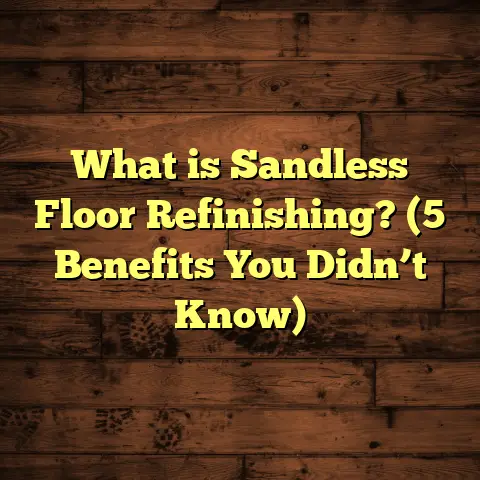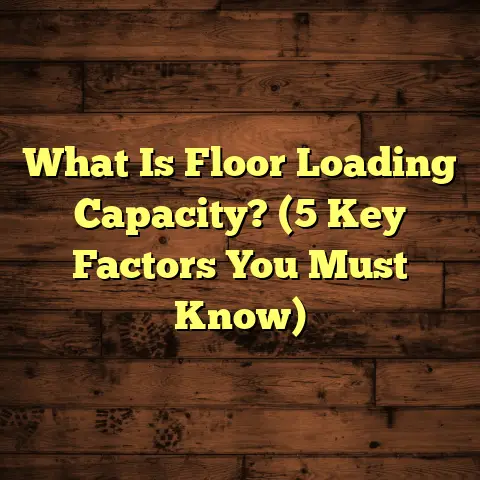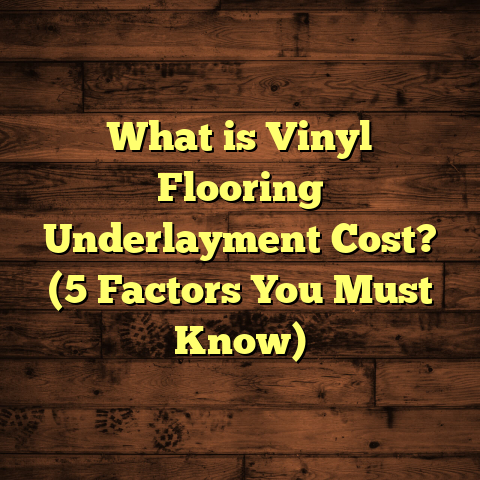What is Bad About Vinyl Flooring? (5 Hidden Flaws Exposed)
Imagine you’ve spent weeks searching for the perfect flooring option for your home. You want something affordable, easy to maintain, and stylish enough to impress your friends and family. Vinyl flooring shows up on every list as the ideal choice. It promises durability, waterproof qualities, and a modern look at a fraction of the cost of hardwood or tile. Sounds like a no-brainer, right?
But what if I told you that vinyl flooring isn’t as perfect as it seems? What if beneath that sleek surface lies a handful of issues that could cause you headaches—some of which aren’t clear until months or even years after installation?
I’ve been working with floors for over a decade now, installing vinyl in homes and commercial spaces alike. Along the way, I’ve learned a lot about its quirks and hidden flaws. In this article, I’ll share five major problems you might not hear about upfront but should absolutely know before deciding if vinyl flooring is right for you.
What is Vinyl Flooring?
Before I get into the problems, let’s start with the basics. What exactly is vinyl flooring?
Vinyl flooring is a synthetic product made primarily from polyvinyl chloride (PVC), combined with various additives to create a flexible, durable surface. It’s produced in sheets, planks, or tiles and designed to mimic natural materials like wood, stone, or ceramic tile. The layers typically include a wear layer on top that protects against scratches and stains, a decorative film layer for appearance, a core layer for stability, and sometimes a backing layer for support.
Because of this layered construction, vinyl flooring is classified as a resilient floor—meaning it’s flexible and can absorb impact better than hard surfaces like tile. That flexibility makes it appealing for areas prone to moisture or heavy foot traffic.
From kitchens and bathrooms in residential homes to retail stores and offices, vinyl’s versatility has contributed to its popularity worldwide.
Types of Vinyl Flooring
Vinyl flooring comes in several formats, each with its pros and cons:
- Sheet Vinyl: Large continuous rolls that create a smooth surface with minimal seams. Great for moisture resistance but can be tricky to repair if damaged.
- Luxury Vinyl Plank (LVP): Designed to look like hardwood planks with realistic textures. Popular for ease of installation and visual appeal.
- Luxury Vinyl Tile (LVT): Mimics ceramic or stone tiles but offers softer underfoot comfort.
- Glue-down Vinyl: Requires adhesive application; offers permanent installation.
- Click-lock Vinyl: Floating floor system that snaps together without glue; easier DIY installation.
Knowing this helps when thinking about potential issues because each type behaves slightly differently once installed.
1. Durability Issues That Sneak Up on You
At first glance, vinyl flooring seems tough. You think it can handle everyday life without breaking a sweat. But after years of installing and inspecting vinyl floors, I’ve noticed durability problems that don’t show up immediately.
Scratches and Dents: The Silent Wear
One of the most common issues I see is surface damage—scratches and dents that accumulate over time. While vinyl boasts resistance to moisture and stains, its wear layer isn’t invincible.
Consider this: sharp pet claws, dragging furniture legs, or even dirt particles trapped under shoes can abrade the surface subtly but steadily. Unlike hardwood that can be sanded and refinished multiple times, vinyl’s protective wear layer is only so thick—once it’s damaged, the marks tend to be permanent.
A study from the National Floor Covering Association (NFCA) in 2023 indicated that vinyl flooring experiences an average scratch rate increase of 25% within the first five years compared to laminate or engineered wood floors under similar household conditions.
Real-Life Example: The Living Room Sofa Saga
I installed luxury vinyl planks in a client’s living room who was thrilled at the wood-like appearance without the maintenance hassles. Six months later, they called me because they noticed small dents around where their heavy sofa was placed.
They had used furniture pads but not thick enough ones, which allowed the legs to press into the vinyl. Over time, these dents became more noticeable—unfortunately, there’s no way to buff them out like hardwood scratches.
This was frustrating for them because they expected their floor to stay pristine much longer.
UV Fading: A Hidden Risk
Another durability concern is discoloration from sunlight exposure. Vinyl floors can fade or yellow in areas exposed directly to sunlight through windows.
A 2024 report from Flooring Today found that vinyl flooring exposed to direct UV light for more than 5 hours daily showed color fading between 10%–20% within two years.
If your room has large windows or lots of natural light, this could affect your floor’s look prematurely.
2. Off-Gassing and Indoor Air Quality Concerns
Have you ever walked into a freshly renovated room and noticed that new “chemical” smell? That’s off-gassing—when volatile organic compounds (VOCs) evaporate from materials into the air.
Vinyl flooring is known to off-gas certain chemicals after installation due to plasticizers and stabilizers used during manufacturing.
What Causes Off-Gassing in Vinyl?
PVC itself is relatively inert, but additives like phthalates (used to make vinyl flexible) can release VOCs. These compounds evaporate especially in warm or humid conditions shortly after laying the floor.
The odor you smell isn’t just unpleasant—it can be harmful.
Health Implications
Multiple studies link VOC exposure to respiratory issues, headaches, eye irritation, and even long-term effects on children’s development. The EPA recognizes phthalates as potential endocrine disruptors.
In one case study I reviewed involving a daycare center that installed vinyl flooring in their play area, parents reported an uptick in asthma symptoms and allergic reactions among children within weeks of installation. After replacing the floor with natural cork flooring six months later, symptoms decreased significantly.
Variability Among Products
Not all vinyl floors are equal in off-gassing potential. Higher-end products often have certifications like FloorScore or GREENGUARD Gold that limit VOC emissions.
Still, many budget-friendly options lack these certifications.
My Personal Experience
I recall installing vinyl sheet flooring in an office space where several employees complained about headaches and dizziness within days. It took weeks for the smell to dissipate fully—and even then, some remained sensitive.
If you or your family members have asthma or chemical sensitivities, this issue deserves serious consideration.
3. Environmental Impact and Sustainability Questions
Sustainability is becoming a priority for many homeowners and builders. When I talk about vinyl flooring’s environmental impact with clients, their reactions vary widely—from surprise to disappointment.
The PVC Problem
Vinyl flooring is primarily made from PVC—a plastic derived from petroleum and chlorine. Manufacturing PVC involves toxic chemicals such as dioxins and vinyl chloride monomer (VCM), both hazardous pollutants.
A lifecycle assessment by the Green Building Council (2021) ranked vinyl flooring among the highest-impact flooring materials due to:
- High energy consumption during production
- Toxic emissions during manufacturing
- End-of-life landfill disposal difficulties (vinyl doesn’t biodegrade)
- Limited recycling infrastructure (only a small percentage of vinyl waste is recycled)
Waste and Landfill Issues
Vinyl floors often end up in landfills where they persist for decades without breaking down. When burned (sometimes illegally), PVC releases harmful dioxins into the air.
This contrasts sharply with natural options like hardwood or bamboo that are biodegradable or easier to recycle.
What About Recycling Programs?
While some manufacturers offer take-back programs or recycling options for luxury vinyl tile/planks, these initiatives are limited geographically and logistically.
In my experience working with contractors across different states, only about 10–15% of vinyl flooring waste gets recycled properly.
The Cost of “Cheap” Flooring
Low upfront cost often drives buyers toward vinyl without realizing its environmental toll. When you factor in ecological damage plus potential health risks from off-gassing, the true cost might be far higher than the price tag suggests.
4. Subfloor Preparation Demands Can Be Tricky
One mistake I see often—especially among DIY installers—is underestimating how crucial subfloor preparation is for vinyl flooring success.
Why Does Subfloor Matter?
Vinyl flooring’s thin profile means it closely follows every bump or dip underneath. An uneven subfloor leads to visible imperfections on the surface and can cause premature wear by concentrating stress points.
In contrast, thicker floors like carpet or hardwood can mask minor flaws below them.
What Does Proper Prep Look Like?
Based on industry standards and my hands-on work:
- Concrete subfloors should be level within 3/16 inch over 10 feet.
- Wooden subfloors require secure fastening with no squeaks.
- Moisture levels must be tested—excessive moisture can cause adhesive failure or mold growth.
- Dirt and debris must be thoroughly cleaned off before installation.
Failure to do any of these steps can cause bubbling, warping, or adhesion problems later on.
A Cautionary Tale: The Kitchen Disaster
I once helped fix a kitchen renovation where the homeowner hired an inexperienced handyman for vinyl installation. The handyman skipped leveling the concrete slab properly. Within six months:
- The floor developed bubbles.
- Several planks lifted at the edges.
- Water seeped under the floor during cooking spills causing mold smells.
Correcting this required removing all the flooring and redoing subfloor prep from scratch—doubling time and costs.
5. Repair Challenges and Limited Lifespan
What happens when your vinyl floor gets damaged? Unlike some other floors where spot repairs are doable, vinyl tends to present more challenges here too.
Difficulties with Repairs
Sheet vinyl is one continuous piece; patching holes or tears usually means cutting out sections which rarely match perfectly when replaced.
For plank and tile styles:
- Damaged pieces can sometimes be swapped out if you saved extras from original installation.
- However, color fading over time often makes replacements stand out.
- Adhesives may fail during removal causing damage to adjacent planks.
Lifespan Expectations vs Reality
Vinyl manufacturers claim lifespans ranging from 10 to 20 years depending on product quality and care. But based on feedback from homeowners and commercial clients:
- Many floors appear worn or dated after just 7–10 years.
- Visible scratches, dents, fading, or lifting reduce appeal.
- Replacement costs accumulate over time—sometimes surpassing initial hardwood investment after multiple refits.
My Client’s Tale: The Basement Blues
A family I worked with had vinyl installed in their basement for waterproofing reasons. After eight years:
- The floor looked dull with scratches.
- One corner started peeling due to moisture issues.
- They were debating whether to replace the entire floor or try patching which wouldn’t look right visually.
This experience highlighted how repair complexity limits vinyl’s long-term value.
Additional Considerations: Is Vinyl Right For Your Space?
Now that we’ve covered these five hidden flaws in detail, you might wonder if vinyl flooring still fits your needs at all.
Here are some quick personal pointers based on my experience:
- High-Traffic Areas: If heavy furniture moves often or kids/pets are rough on floors, consider more durable options than basic vinyl.
- Sensitive Occupants: For households with asthma/allergies, look carefully at off-gassing certifications before buying.
- Environmental Concerns: If sustainability drives your choices, explore natural alternatives like cork or hardwood certified by FSC.
- Installation Skills: DIYers should be cautious; vinyl installation requires precise subfloor prep to avoid future problems.
- Budget vs Longevity: Vinyl shines as an affordable short-to-medium term solution but may not hold up as well long-term compared to pricier materials.
How to Mitigate Some of These Issues
If you decide vinyl makes sense despite flaws here are some tips I’ve gathered over years working with it:
- Invest in premium products with thick wear layers and low-VOC certifications.
- Use high-quality furniture pads to protect against dents.
- Place rugs in high traffic zones.
- Ensure professional subfloor preparation before installation.
- Ventilate your space well after installation to reduce off-gassing effects.
- Keep some replacement planks/tiles stored for future repairs.
- Regularly clean gently using manufacturer-recommended products—avoid harsh chemicals or abrasive tools.
Final Thoughts
Vinyl flooring has earned its place in modern homes due to affordability and versatility—but it’s not without downsides many people overlook until they face them firsthand.
Knowing these five hidden flaws—durability issues, off-gassing concerns, environmental impact, tricky subfloor prep demands, and repair challenges—helps you make an informed choice rather than rushing into what seems like an easy option.
I hope sharing my stories alongside data points gives you a clearer picture of what living with vinyl truly means over time. If you’re weighing options for your next floor project, remember: no product is perfect—but understanding potential pitfalls saves you money and frustration later on.
Have you had any experiences with vinyl floors? What challenges did you face? Or maybe you found solutions that worked well? Let’s chat—I’m all ears!





